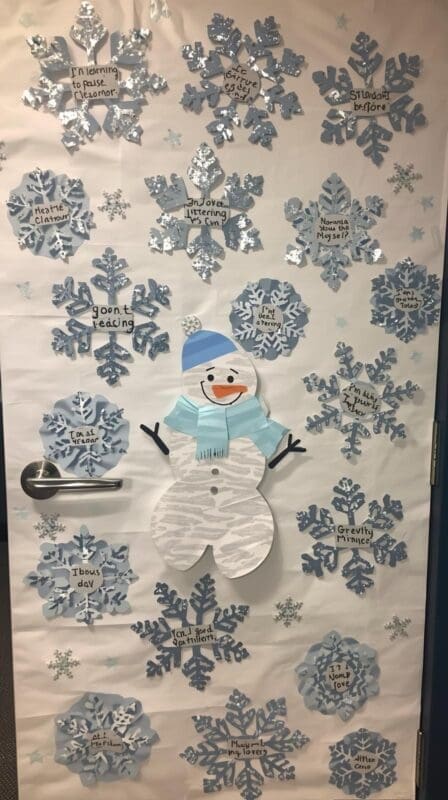When the Hallway Becomes a Hug
One cold December morning, I was walking past our school counselor hallway when I saw something that stopped me in my tracks: a door wrapped in soft blue paper, decorated with paper snowflakes and the words “You’re Worth Melting For.”
It wasn’t flashy or perfect — but it felt warm. Kids passing by slowed down, smiled, and whispered to each other about how nice it looked. One little girl even touched the paper snowflakes and said softly, “I love this one.”
That moment reminded me of something I’ve always believed: classroom doors are more than decorations — they’re emotional spaces.
Whether you’re a counselor helping students find calm or a teacher setting the tone for learning, your door is the first “hello” they see each day. During winter, when emotions often run high and sunlight runs low, thoughtful decor can spark comfort, hope, and belonging.
This guide gathers winter classroom decoration ideas that blend mindfulness, inclusivity, and a touch of seasonal magic — all designed for educators and counselors who care about how spaces feel.
The Power of Visual Warmth in Cold Months
When daylight fades early, sensory environments matter more than ever.
Soft colors, kind messages, and organic textures help soothe overstimulated nervous systems — especially for students coping with anxiety or winter blues.
From a psychology perspective, visual cues like snowflakes, stars, and cozy tones can promote feelings of calm and predictability. From a school counseling standpoint, symbolic design helps nonverbal emotional communication: “You are safe here.”
Counselor Insight:
“Students might forget your exact lesson, but they’ll always remember how your space made them feel.”
A winter-themed door doesn’t have to be Pinterest-perfect. It just needs to reflect warmth, emotional safety, and genuine care.
Cozy Winter Door Themes for Calm & Comfort
Here are thoughtful winter classroom door ideas that combine cozy aesthetics with emotional connection — ideal for both counselors and teachers.
1. “Warm Hearts in a Cold Season”
Supplies:
- Light blue or gray background paper
- Red and pink construction paper hearts
- Printed or hand-lettered quote: “Warm hearts make bright days.”
- Soft white fairy lights (optional)
How to Create It:
Cover your door in sky-blue paper. Add hearts of different sizes and have students write acts of kindness they’ve noticed or done. Wrap the edges with fairy lights for glow.
Why It Works:
- Encourages gratitude and empathy reflection.
- Provides a visual warmth contrast to cold weather.
- Integrates perfectly with counselor-led kindness weeks.
Therapist Note: Acts of kindness increase serotonin for both giver and receiver — your door becomes a daily mood booster.
2. “Snow Much Growth!” (SEL Focus)
Supplies:
- White background paper
- Paper snowflakes or snowballs labeled with student goals
- Snowman cutouts with SEL prompts
How to Create It:
Ask students to write one social-emotional skill they’re practicing this winter (“I’m learning to pause before reacting,” “I’m being kinder to myself”). Display them on snowflakes surrounding a snowman.
Why It Works:
- Reinforces growth mindset and emotional regulation goals.
- Provides easy weekly reflection prompts during counseling sessions.
3. “You’re Worth Melting For” (Emotional Safety Theme)
Supplies:
- Silver or blue paper background
- Snowman illustration or cutout
- Puffy paint or cotton batting for snow texture
How to Create It:
Center a cheerful snowman holding a heart. Add student or staff names on individual snowflakes floating around.
Why It Works:
- Conveys belonging and unconditional value.
- Visually soft — ideal for counseling offices or wellness corners.
Counselor Tip: Include a “mirror snowflake” — a laminated circle that says, “This one’s for you.”
4. “Let It Snow, Let It Grow”
Supplies:
- Brown paper “tree”
- Cotton ball snow
- Quote: “Every season helps us grow.”
How to Create It:
Draw a large tree bare of leaves, then add cotton-ball snow at its base and words of growth (resilience, patience, courage) on each branch.
Why It Works:
- Represents emotional development through cycles.
- Integrates mindfulness and reflection beautifully into winter decor.
Mindful Reflection:
Trees grow even when it’s cold — so do students.
5. “Our Words Can Warm a Room” (Communication Skills Theme)
Supplies:
- Orange, red, and yellow paper for “flames”
- Fireplace outline drawn or cut from brown craft paper
- Sticky notes for students to write encouraging phrases
How to Create It:
Design a simple paper fireplace. Add “flames” labeled with positive communication skills (“listening,” “kind words,” “asking for help”).
Why It Works:
- Great SEL activity — connects emotional warmth to verbal kindness.
- Encourages self-awareness of tone and language.
OT Connection: The physical act of writing reinforces cognitive processing — students “feel” their positive words through movement.
Inclusive & Culturally Sensitive Winter Door Ideas
Winter celebrations can be complicated in diverse schools. These inclusive ideas keep the focus on universal emotions rather than specific holidays.
1. “Light in Every Heart”
Use stars, lanterns, or candles to represent shared hope and resilience.
Add affirmations from students about what brings them light in winter.
Example quotes: “Music,” “My grandma,” “My counselor,” “Quiet time.”
2. “We Shine Brighter Together”
Cover your door in navy or black paper with gold stars. Each star holds a student’s name or personal strength.
Psychological Symbolism: Unity and self-worth; reinforces identity and belonging.
3. “Kindness Is Our Tradition”
Show paper mittens or scarves connected across the door, symbolizing community care.
Counselor Insight:
Inclusive decor reminds every student they belong, regardless of culture or celebration style.
Simple DIY Details That Transform a Door
Sometimes, small textures and sensory details make the biggest emotional difference.
- Add Soft Texture: Use felt snowflakes, velvet ribbons, or cotton “snow” for tactile comfort.
- Use Natural Elements: Dried oranges, cinnamon sticks, or eucalyptus sprigs bring grounding scent.
- Try Gentle Lighting: Battery-operated fairy lights or warm LED candles create calm visual rhythm.
- Use Neutral Palettes: Shades of cream, pale blue, blush, and sage are psychologically soothing compared to bright red/green contrasts.
Affiliate Hooks: “faux eucalyptus garland,” “LED candles with remote,” “classroom-safe fairy lights.”
Collaborative Doors That Build Connection
Involve your students or counseling groups — shared creation builds ownership and belonging.
“Snowflakes of Strength”
Each student writes one personal strength or coping skill on a snowflake.
Hang them together as a collective “strength storm.”
“The Things That Make Us Feel Cozy”
Have students draw or write their comfort rituals — cocoa, reading, hugs — to normalize self-soothing habits.
“Our Community Quilt”
Cut paper squares for students to design symbols of kindness or courage. Tape together as a paper quilt across your door.
Therapist Note: The act of decorating together activates mirror neurons — shared creation builds empathy and co-regulation.
For Counselors — Turning Decor into a Therapeutic Tool
Winter doors can double as micro-interventions.
Each visual prompt can initiate emotional dialogue or reinforce skills learned in session.
Ideas for Counselors:
- Add a “Weekly Thought” snowflake with a mindfulness question.
- Post a rotating “Emotion Word of the Week.”
- Display coping skill cards — students can take one if they need a reset.
- Create a “Joy Jar” envelope on your door — students slip in good news or positive notes.
Professional Tip: Decor becomes psychoeducation when it connects environment with intention.
The Psychology of Warm Spaces
Environmental psychology shows that visual warmth reduces perceived stress.
Colors like cream, peach, and pale gold activate oxytocin and social bonding responses.
Rounded shapes (hearts, snowflakes, curves) are processed as safer than angular ones, lowering amygdala activity.
Counselor Insight:
“Students mirror the emotional tone of their environment — when we soften the space, we soften behavior.”
A well-designed winter classroom door is like a gentle exhale between busy classes. It says: You can rest here.
Decorating as a Form of Care
A winter classroom door might seem small, but it’s a message on paper:
“I see you. You belong. You’re safe.”
These winter classroom decorations aren’t about perfection — they’re about emotional presence. They help transform a hallway into a haven, a simple door into an open heart.
So this season, take a few minutes between lessons or sessions to add something meaningful. Let your space reflect what your work already teaches every day — compassion, connection, and calm.
You might also like:
- DIY Winter Therapy Office Decor Ideas
- Mindful Art Projects for Counselors
- Spring Classroom Decor Ideas for Emotional Wellness
Because healing isn’t just something we teach — it’s something we practice, one mindful moment at a time.

About the Author
Hi, I’m Eve, a former school counselor with a master’s degree in School Psychology and a passionate advocate for children and families navigating sensory challenges. As a mom of children with sensory sensitivities, I deeply understand the journey special-needs parents face, and I dedicate myself to researching and sharing practical solutions to help children thrive and feel comfortable in their bodies. My goal is also to empower counselors, therapists, and psychologists with creative strategies and supportive resources to enrich their everyday practice. When I’m not writing or exploring new therapeutic approaches, you’ll find me spending quality time with my family and continually seeking inspiration from everyday moments.





